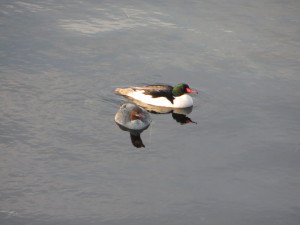by Dana Little, July 2009
This year I observed a breeding Common Merganser for the first time on Taylor Pond. This merganser is a large bird typically over two feet in length with a wingspan of nearly three feet. The female, which I observed, has a brown head with a short crest behind. The bill is bright red and serrated to hang on to the fish for which it dives. The body is a light gray that blends into the background making the mother hard to observe. My son, Robbie, first saw her carrying three newly-hatched chicks on her back July 12th. When I saw her on the 13th and subsequent days only one chick remained. Both mother and chick could be observed swimming along with their head held at water level with the eyes below to spot fish. One can see this fish-searching behavior often in the Common Loon which is a regular visitor to Taylor Pond. Whenever the baby merganser startled, it quickly jumped onto its mother’s back and rode away. The Common Merganser typically prefers deep, clear lakes and rivers and subsists mostly on small fish caught underwater while swimming. The adults usually nest in a tree cavity near water 15-20 feet above ground and lay 8-11 eggs. During the winter they can be spotted in the Androscoggin River just below the falls and anywhere along the southern Maine coast. When the ice melts in the spring this bird is one of the first to make an appearance along with the Wood Ducks and Hooded Mergansers in the open water near the shoreline of Taylor Pond.
Pair of Common Mergansers
Yellow-billed Cuckoos can be heard at this time of year commonly calling in the thickets surrounding Taylor Pond. This species has declined 42 percent since 1980 according to Breeding Bird Survey data. I have difficulty spotting the adult as they like dense vegetation but occasionally they can be seen flying around my yard. They typically lay 4 eggs in a nest found in low shrubs. The young develop rapidly and are out of the nest within 3 weeks. The adults love to eat tent caterpillars and cicadas and when large outbreaks of these insects occur, the adults will lay many more eggs than usual. Although you are unlikely to spot this bird soon, you can detect its presence by learning the song by going to the Macauley Library, Cornell Lab of Ornithology.
